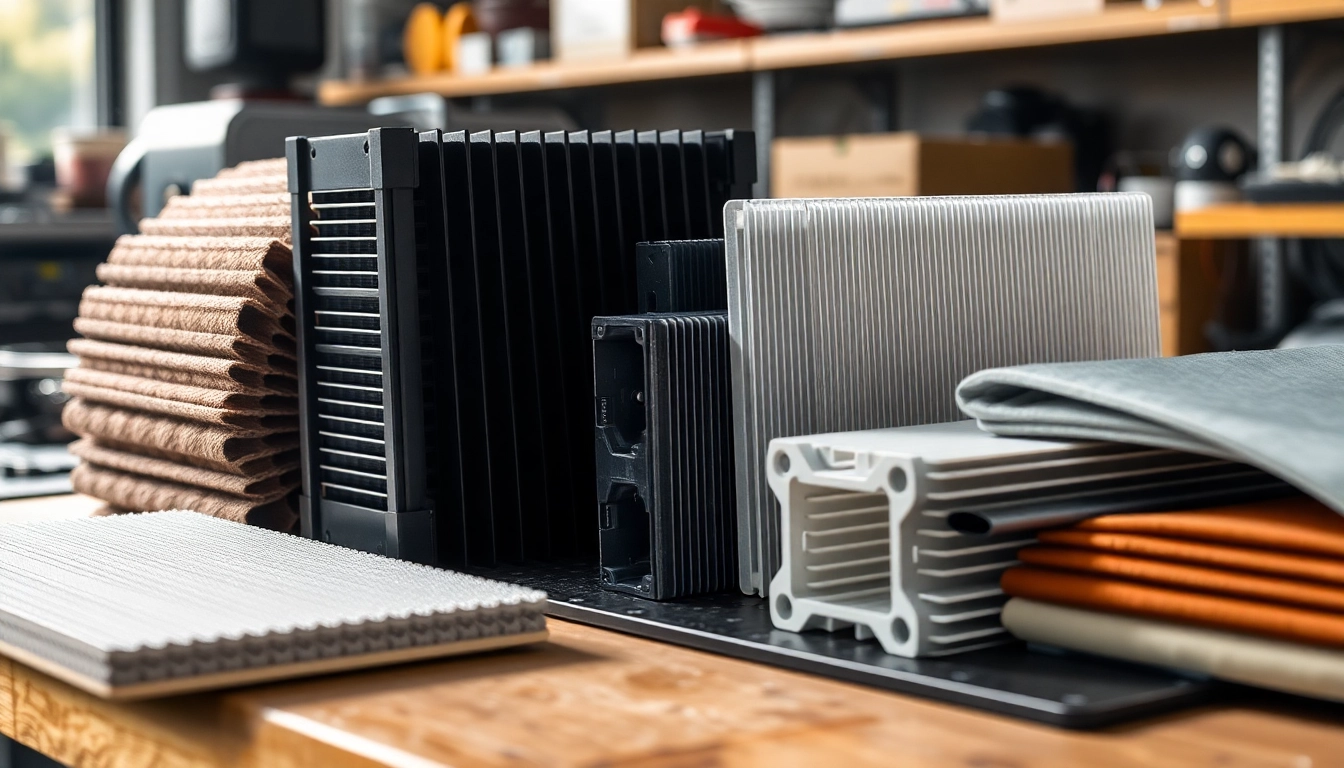Introduction to Thermal Management Materials
In today’s technology-driven world, ensuring optimal thermal management in electronic devices is critical to maintaining performance and longevity. Thermal management materials play a pivotal role in dissipating heat, enhancing cooling efficiency, and facilitating the reliable operation of devices in a wide array of applications. This article delves into the intricacies of thermal management materials, their significance, types, and applications, along with best practices for implementation and future trends in the industry.
What are Thermal Management Materials?
Thermal management materials are specially designed products that help in controlling temperature through effective heat dissipation in electronic assemblies. These materials work by enhancing thermal conduction, reducing thermal resistance, and providing thermal insulation as necessary.
They can take various forms, including thermal interface materials (TIM), encapsulants, adhesives, gap fillers, and phase change materials. Each type has unique properties and applications, catering to specific needs within the electronic sector.
Importance of Thermal Management in Devices
The performance of electronic devices is heavily influenced by their operating temperature. Excessive heat can lead to:
– Decreased performance
– Reduced lifespan of components
– Increased energy consumption
– Potential failure or damage
Effective thermal management is essential for preventing overheating, enhancing efficiency, and ensuring the reliability of devices. This is especially crucial in high-performance applications such as automotive electronics, consumer gadgets, and industrial systems, where failure to manage heat adequately can have severe implications.
Types of Thermal Management Materials
There are several categories of thermal management materials, each serving different functions:
1. Thermal Interface Materials (TIMs): These materials facilitate heat transfer between a heat-generating component and a heat sink or spreader. They can be thermal pads, greases, or adhesives, designed to fill microscopic air gaps and enhance thermal conduction.
2. Gap Fillers: These are soft, conformable materials that fill the voids between components, improving thermal contact. Commonly used in situations where the gap is irregular, gap fillers enhance heat transfer efficiency.
3. Phase Change Materials (PCMs): These materials absorb or release heat as they change phases (solid to liquid or vice versa), thus maintaining temperature stability in applications where temperature fluctuations need to be minimized.
4. Thermal Adhesives: Specifically formulated adhesives with high thermal conductivity, these materials bind components together while ensuring effective thermal transfer.
5. Insulating Materials: For certain applications, preventing heat transfer is essential. Insulating materials ensure that heat does not escape from a designated area, protecting sensitive components and maintaining overall system efficiency.
Key Features of Effective Thermal Management Materials
When selecting thermal management materials, several key features should be considered to ensure optimal performance.
Conductivity and Performance Metrics
The most critical factor in thermal management materials is thermal conductivity, which is the ability to conduct heat effectively. This property is usually measured in watts per meter-kelvin (W/mK). High-performance materials may have conductivities ranging from:
– 5 to 25 W/mK: Typical for thermal greases or pads.
– 25 to 150 W/mK: Found in materials like graphite or certain silicone-based compounds.
– Above 150 W/mK: This range is typically seen in advanced materials like metal matrix composites.
Performance metrics also include thermal resistance, compressibility, and the ability to withstand varying temperatures and environmental conditions.
Durability and Environmental Considerations
Durability is vital, especially in applications subjected to mechanical stresses, thermal cycling, or harsh environments. Factors to consider include:
– Thermal Stability: Materials should retain their properties over extended temperature ranges without degradation.
– Chemical Resistance: Resistance to solvents, oils, and other environmental factors is essential to maintain integrity.
– Mechanical Properties: High tensile strength and flexibility often dictate the performance of materials in real-world applications.
Sustainability is increasingly becoming a critical consideration in selecting thermal management materials. Manufacturers are exploring eco-friendly alternatives that reduce environmental impact while maintaining functionality.
Cost vs. Quality Analysis
While cost is an essential consideration, it’s crucial to evaluate quality alongside expenditure. Cheaper materials may lead to higher thermal resistance, inefficiencies, and ultimately increased operational costs due to overheating and early component failure. A holistic view of the entire lifecycle cost—including initial investment, performance, and potential failures—should guide decisions in material selection.
Applications of Thermal Management Materials in Electronics
Thermal management materials find application across various sectors, addressing different thermal challenges specific to each industry.
Consumer Electronics
Consumer electronics, including smartphones, laptops, and gaming consoles, generate significant heat during operation, particularly during extensive use or charging. Efficient thermal management ensures that devices can operate at peak performance without overheating.
Materials like TIMs and phase change materials are widely used in these applications, providing effective heat distribution and dissipation. Manufacturers are continuously innovating to enhance the efficiency of thermal management solutions, leading to slimmer devices with powerful processors.
Industrial Systems
In industrial applications, systems such as electric motors, power converters, and control units often face extreme operating conditions. Robust thermal management materials are critical to ensuring operational efficiency. These systems utilize a combination of gap fillers, thermal insulations, and adhesives capable of withstanding high stress and temperature variations.
The industrial landscape demands solutions that provide not just performance but also reliability. The failure of a thermal management solution can lead to system failures, costly downtime, and potential hazards.
Automotive Applications
The automotive industry has increasingly leaned towards electric and hybrid vehicles, which require advanced thermal management materials to mitigate the challenges associated with battery management systems. Effective heat dissipation is crucial to preventing thermal runaway in lithium-ion batteries and maintaining vehicle performance.
Thermal interface materials and phase change materials are often employed in these systems, as they help maintain optimal operating temperatures, thereby enhancing safety and longevity. Innovations in thermal management solutions are vital as the industry moves toward sustainability and higher efficiency standards.
Best Practices for Implementing Thermal Management Solutions
Implementing thermal management materials requires careful planning and execution to achieve optimal results.
Choosing the Right Thermal Management Material
When selecting thermal management materials, consider the following factors:
– Thermal Performance: Evaluate the thermal conductivity and resistance properties against specific application requirements.
– Material Compatibility: Ensure that selected materials are compatible with other materials in use, including adhesives and encapsulants.
– Environmental Factors: Analyze the conditions in which the materials will operate, including temperature extremes and exposure to chemicals.
– Regulatory Compliance: Depending on the industry, some materials may need to adhere to specific regulatory standards.
Collaborating with manufacturers or experts in the field can provide insights into the most suitable choices for different applications.
Installation Techniques for Optimal Performance
Proper installation is crucial for maximizing the effectiveness of thermal management materials. Key techniques include:
1. Surface Preparation: Ensure that surfaces are clean and free from contaminants before applying any thermal interface materials.
2. Application Thickness: Adhere to manufacturer guidelines regarding the appropriate thickness of TIMs and gap fillers; incorrect thickness can impede performance.
3. Use of Equipment: Utilize tools such as thermal pressing machines to ensure even application and minimize air gaps, especially in TIM installations.
4. Regular Quality Checks: Conduct quality control assessments during installation to identify any inconsistencies early.
Regular Maintenance and Performance Monitoring
Algorithms and platforms for real-time monitoring of device temperatures enable proactive maintenance of thermal management systems. Regular assessments can help identify potential failures or areas of improvement.
Ensuring that thermal management materials maintain their integrity and effectiveness is paramount. Scheduled inspections focusing on material deterioration or thermal performance can significantly enhance device reliability and economic efficiency.
Future Trends in Thermal Management Materials
As technology evolves, so too does the field of thermal management materials, driven by the demand for higher performance and sustainability.
Emerging Technologies in Thermal Solutions
Innovative technologies such as advanced composites, nanomaterials, and smart materials are being developed to enhance thermal management solutions. These materials often feature engineered thermal pathways, enabling significant improvements in thermal conductivity and performance. Smart thermal materials that can adapt to changing thermal conditions in real-time provide promising avenues for next-generation applications.
Recycling and Sustainability in Thermal Materials
The emergence of circular economy principles is transforming the production and disposal of thermal management materials. Manufacturers are beginning to emphasize the recyclability of materials and the use of sustainable resources. Biodegradable thermal interface materials and eco-friendly adhesives are being prioritized, allowing for reduced environmental impact while maintaining necessary performance levels.
Anticipated Innovations in the Industry
The thermal management field is expected to see continuous advancements in material science, leading to innovative solutions that address emerging challenges. Hybrid materials combining different thermal properties, new fabrication techniques, and artificial intelligence for monitoring and predicting thermal behavior are anticipated trends that could redefine thermal management as we know it.
Conclusion
In conclusion, thermal management materials are indispensable components in today’s electronic devices, ensuring reliable operation and prolonged longevity. By understanding the types, features, and applications of these materials, along with best practices for implementation, businesses can significantly enhance their thermal management strategies. Looking ahead, the continued evolution of these technologies, driven by sustainability and innovation, promises to shape the future of how we think about heat management in electronics.




